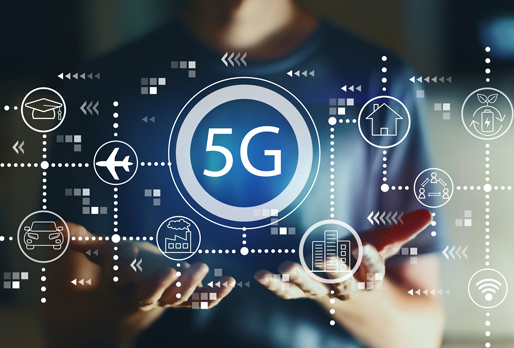The last few weeks in the 5G arena had been really exciting for India. Multiple telecom service providers announced 5G plans coupled with trial results. Department of Telecommunications (DoT) first permitted major operators to conduct 5G trials. The trial includes reuse of existing lower-band spectrum, experimental new mid-band, and millimeter-wave. Thanks to this, operators can now flexibly run trails on a broader range of 5G frequencies and test different use cases. The exciting 5G journey has started and is the sunrise sector of digital India. GSMA prediction underlines economic significance —5G will contribute USD 450 billion by 2040 to the Indian economy.
As per Accenture's latest survey, 79% of global businesses believe that 5G will have a notable impact on enterprises. 59% of these businesses believe that 5G will be revolutionary. All because of high speed, consistency, latency reduction it provides, and promise to disrupt traditional & digital sectors. The use cases will pave the path for smart cities, automated factories, automated vehicles, and a new business communication wave. Have a look:
1. Smart Cities
Make your inbox more interesting.
Every week, get an overview of the day’s biggest news from the Telecom and OTT space.Alba Iulia Smart City, developed in conjunction with Orange, is a classic use case. Thanks to 5G, the Romanian city includes smart waste management, parking sensors, and congestion monitoring.
Soon 5G will enable smart factories. This will include robots in production lines, drones in last-mile delivery, fully automated cars, and car-to-car communication around incidents.
2. Autonomous Vehicles
Waymo, CTO, who started life in 2009 with Google Self-Driving Car Project, confirms that when it comes to autonomous car fleet development for the enterprise —5G is a key enabler.
He adds, in comparison to self-driving cars that depend on onboard computation for each & every module related to safety, 5G is an accelerator. It will help with bandwidth, latency, and communication.
Recently O2 has announced a trial driverless cars project in London. This uses a 5G network. The prime focus is to develop a robust road management system with 10% reduced time spend by a motorist in traffic. Also, to improve productivity & boost the economy by £880m a year and reduce CO2 emission by 370,000 metric tonnes/year.
In January 2020, BMW and Samsung at the Consumer Electronics Show depicted companies' efforts in connected cars and revealed the 5G TCU (Telematics Control Unit). This TCU will be a part of BMW iNext, coming this year. Enterprises are not only using 5G to enable greater autonomy levels but also to reveal detailed-oriented information. In collaboration with Siriraj Hospital and Thailand NBTC (National Broadcasting and Telecommunication Communication), Huawei has recently launched a new project. This includes 5G-powered self-driving vehicles to deliver medical supplies.
3. 5G Drones
Verizon wishes to be the first telco to usher 5G in aviation. The prime focus is to connect and integrate drones in the national airspace and enable a million connected flights.
The idea is backed by Skyward, which Verizon bought in 2016. Skywards specializes in drone operations for enterprises and businesses. It provides detailed mapping to drone operators simultaneously while operating industrial drones. Also, Skyward includes tools to keep multiple drones in action and check what needs to go where.
Here, the plan is to connect as many drones as possible, transmit video in real-time, keep a tab on warehouse stock and other intelligence.
Mariah Scott, the Skyward president, confirms that they have already started 5G-connected drone testing on the Verizon network. Now, 5G ultra-wideband is a new aviation era. It will connect and integrate drones into the national airspace.
Currently, in Pontypool, Wales, 5G-connected delivery drones are in testing by Irish startup Manna.
4. Immersive Entertainment
From Star Wars: The Rise of Skywalker, Verizon highlighted the real-time rendering effects of 5G. The network partnered with StudioLAB Walt Disney Studio to demonstrate how guests can interact with Sith Troopers in real-time.
The role of troopers was played by two actors working in a remote location and 15 miles apart. Verizon and StudioLAB confirm that 5G will entirely change the entertainment media industry from creation, distribution, and consumption. 5G low latency and speed will bring forth new creative capabilities. It's high time to deliver 5G's early access to storytellers to get unparalleled experiences worldwide.
Connectivity is significantly important today, especially when it comes to sports. Fans are not only inclined towards watching the game alone. They want to post content on social channels, access additional information, and watch highlights.
As a result, connectivity is the new normal for sporting companies. Unfortunately, the existing Wi-Fi and mobile networks are incapable of handling such densely populated environments. Not to worry, 5G is the counter.
The latest study by Ovum and Amdocs confirms that 90% of mobile operators are planning to hold 5G sporting experience trails at stadiums. It will enable new experiences and augment fan satisfaction.
Using Augmented Reality, the German FA is planning to have real-time fan view data insights.
5. Manufacturing
However, 5G first generation confirms latency of 10ms which will be almost negligible in second-gen. 5G networks can theoretically reduce latency to a single millisecond using URLLC (Ultra-Reliable and Low Latency Communications). Apart from this, there are several benefits: high-precision assembly lines where robots and machines all sync in real-time, human controlling devices via single touch, IoT mass adoption, and more.
Introducing 5G in manufacturing is to enable connected sensors on machines and IoT full deployment. This will help in predicting roadblocks, viewing them emerging in real-time and hence reducing production downtime. This is all about abandoning the traditional approach to embrace connected systems and encourage streamlined automation. AI-capable analytics software will be the cherry on the cake here. It will help to bite real-time data on every equipment and machine.
6. Agriculture
5G will also back traditional sectors such as agriculture. The industry will use 5G sensors to collate real-time information about moisture needs, livestock, fertilization, must to conserve energy. Smart farms with MooCall sensor services are clear-cut evidence. This sensor can be attached to a cow's tail, and it helps predict when a cow is about to give birth.
An autonomous tractor is another excellent example highlighting connected vehicles. Their manufacturing is already in progress for the US and other markets. The demonstration of a remote-controlled tractor in Helsinki by Valtra is not to be missed. This tractor can be controlled from a vast distance using a 360-degree camera mounted on the top. Why? Because it sends 4K images back to the driver.
By introducing precision farming, 5G has revolutionized agriculture impressively. Instead of treating the entire field exclusively, farmers can provide unified treatment as per needs. So, reduced input, food, water, fertilizers, to herbicides.
7. Healthcare
Remote diagnosis and operations, responsive wearables, e-health, AI-assistant for the disabled will be the next normal in healthcare. Verticals such as interactive physiotherapy specialists Immersive Rehab are already exploring how 5G can improve their offerings. 5G trails such as Liverpool 5G Testbed are already in progress.
5G has already marked its presence in the operation theatre in Malaga hospital. It is the first assistance surgery system that runs purely on 5G technology. The best part is zero latency. The testing of “Smart ambulances” equipped with 5G technology is also in progress. The test will happen on six ambulances that will provide new services such as high-quality scanners and real-time video technology.
8. Oil & Gas
Vodafone partnered with Centrica Storage to build the future gas plant at their Easington site. This will deliver a 5G-ready mobile private network (MPN) to the facility. It is the first of its kind in the oil and gas sector for the US.
Thanks to this 5G infrastructure, Centrica Storage will be able to automate, monitor, and centralize a significant portion of its key maintenance and engineering operations. Using real-time data, Centrica Storage can easily monitor its facility, reduce costs, and streamline operational resources. Last but not least, 5G will improve safety, allow engineers to utilize virtual reality headsets for undertaking training and essential maintenance work.


